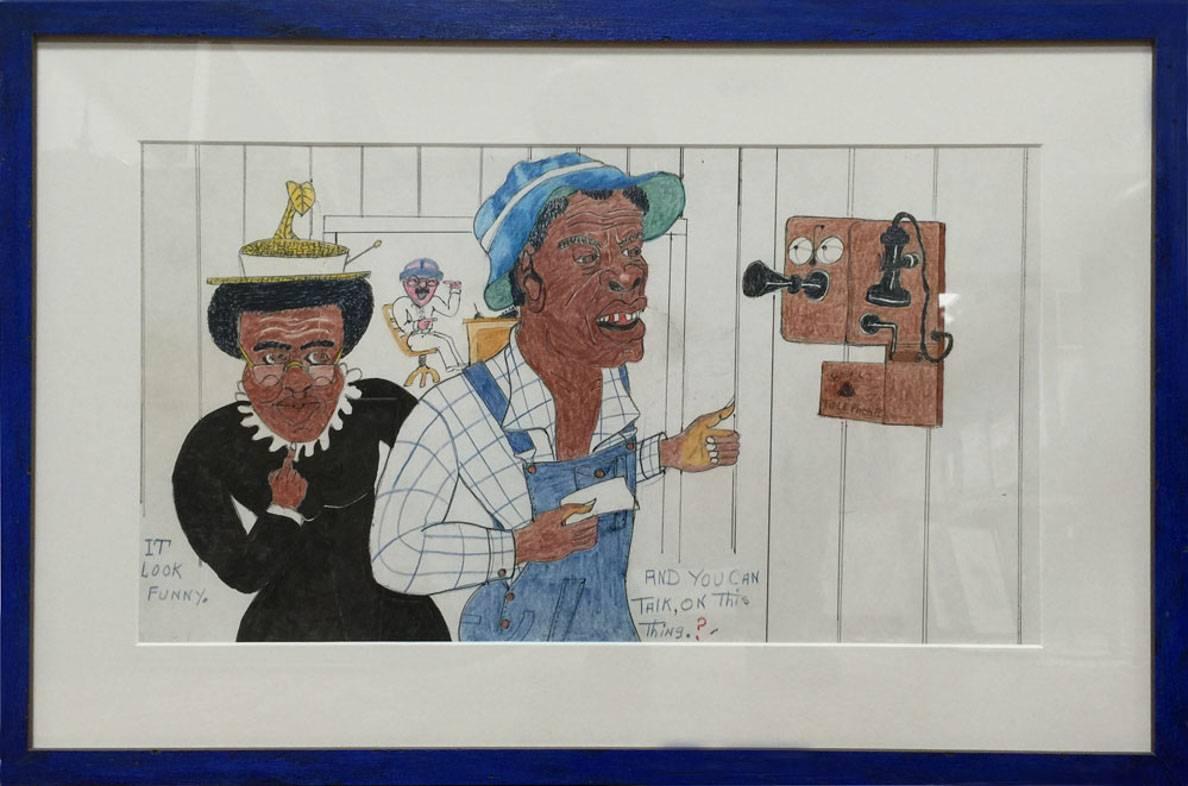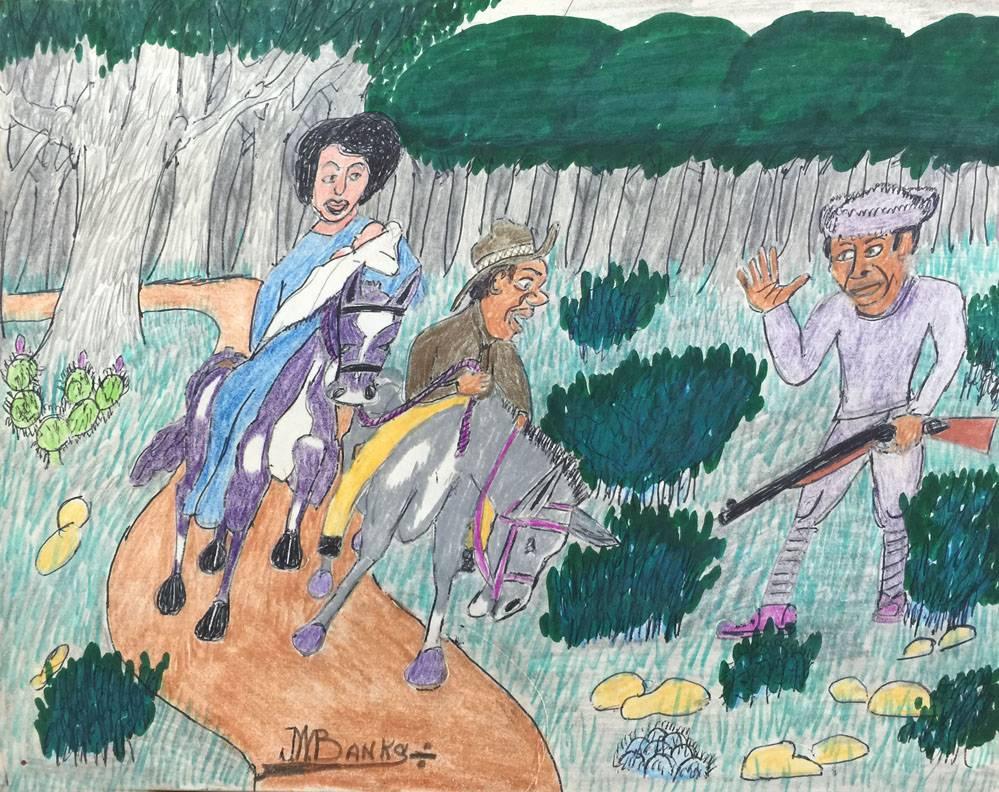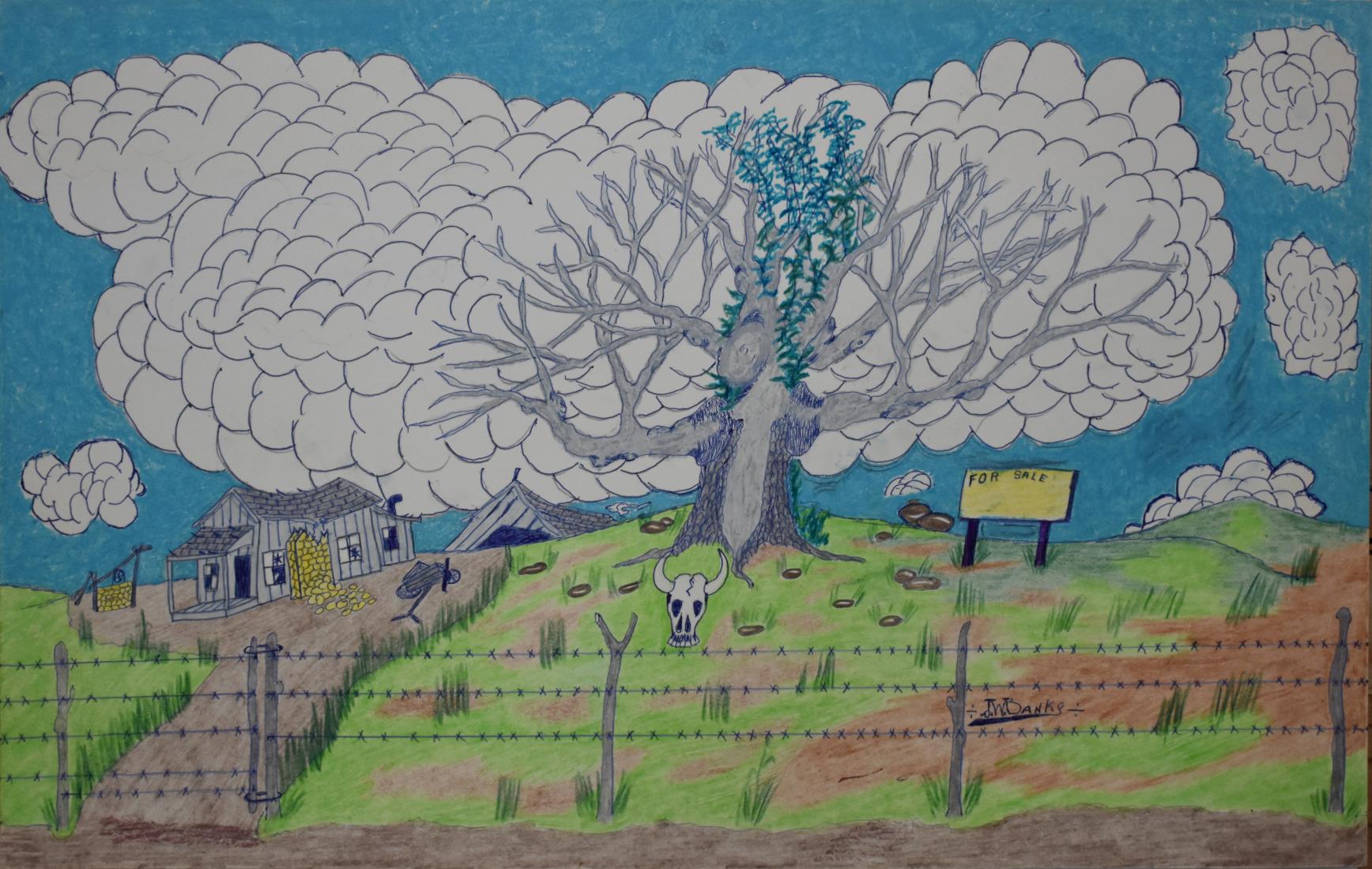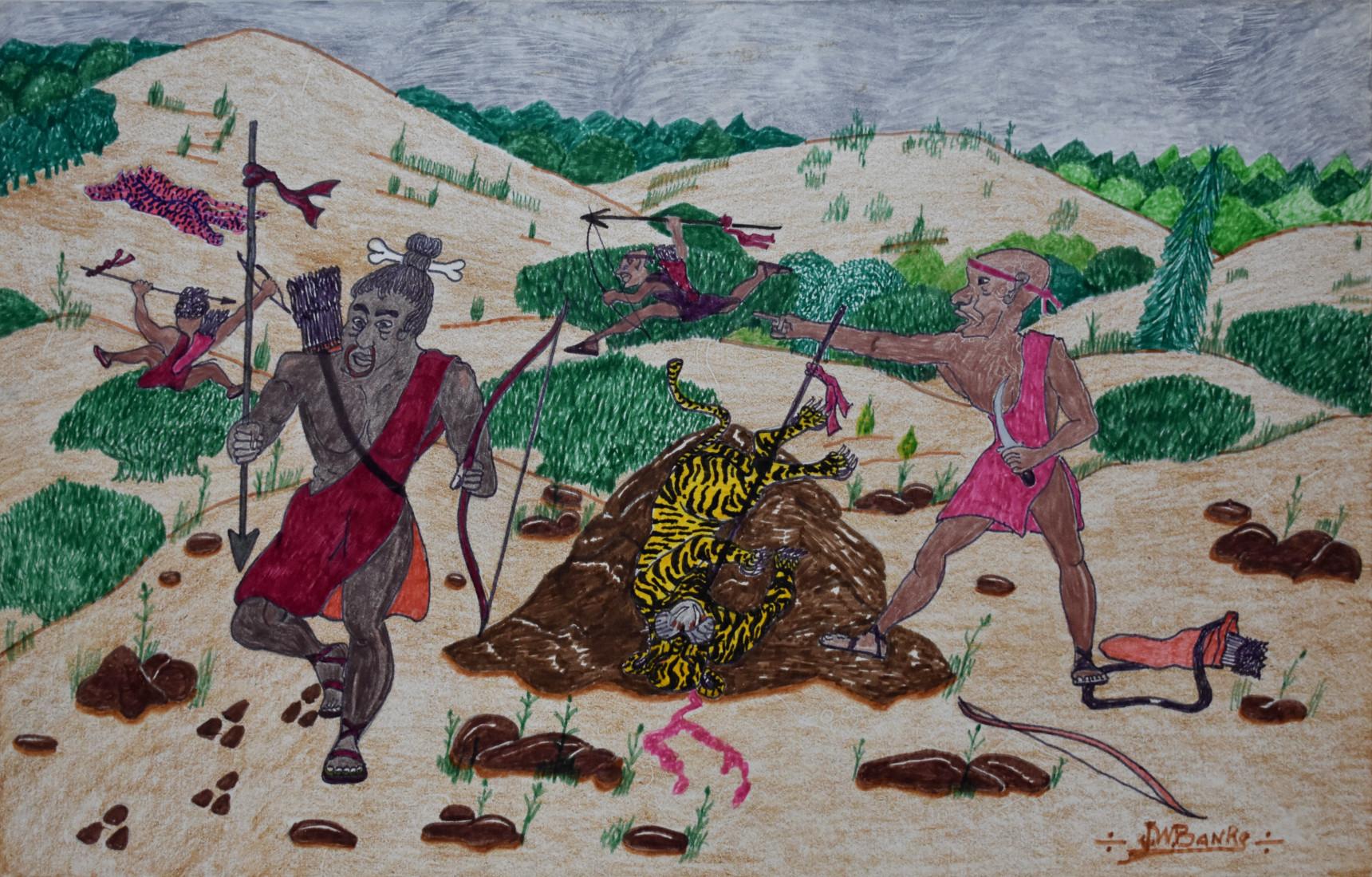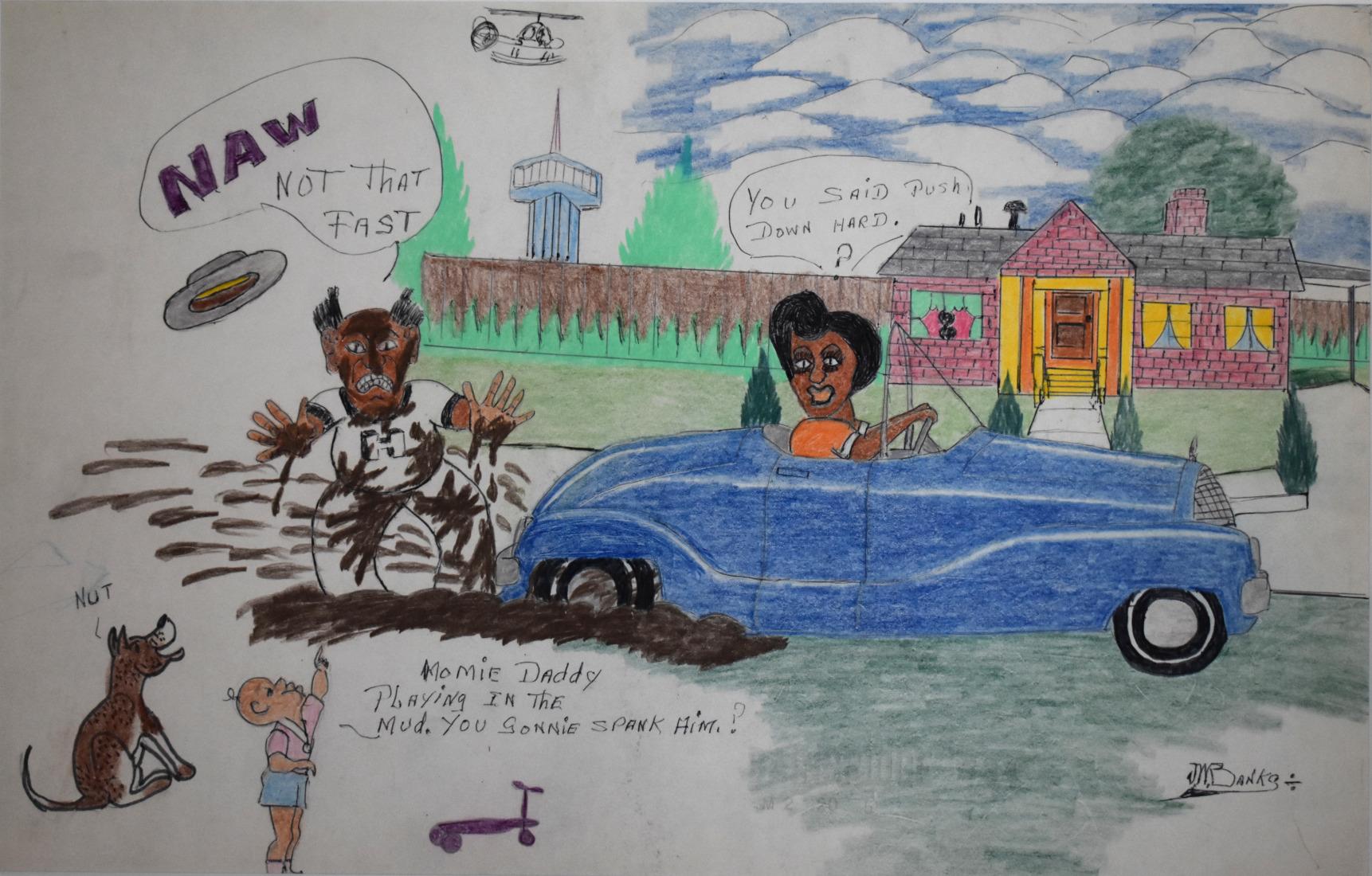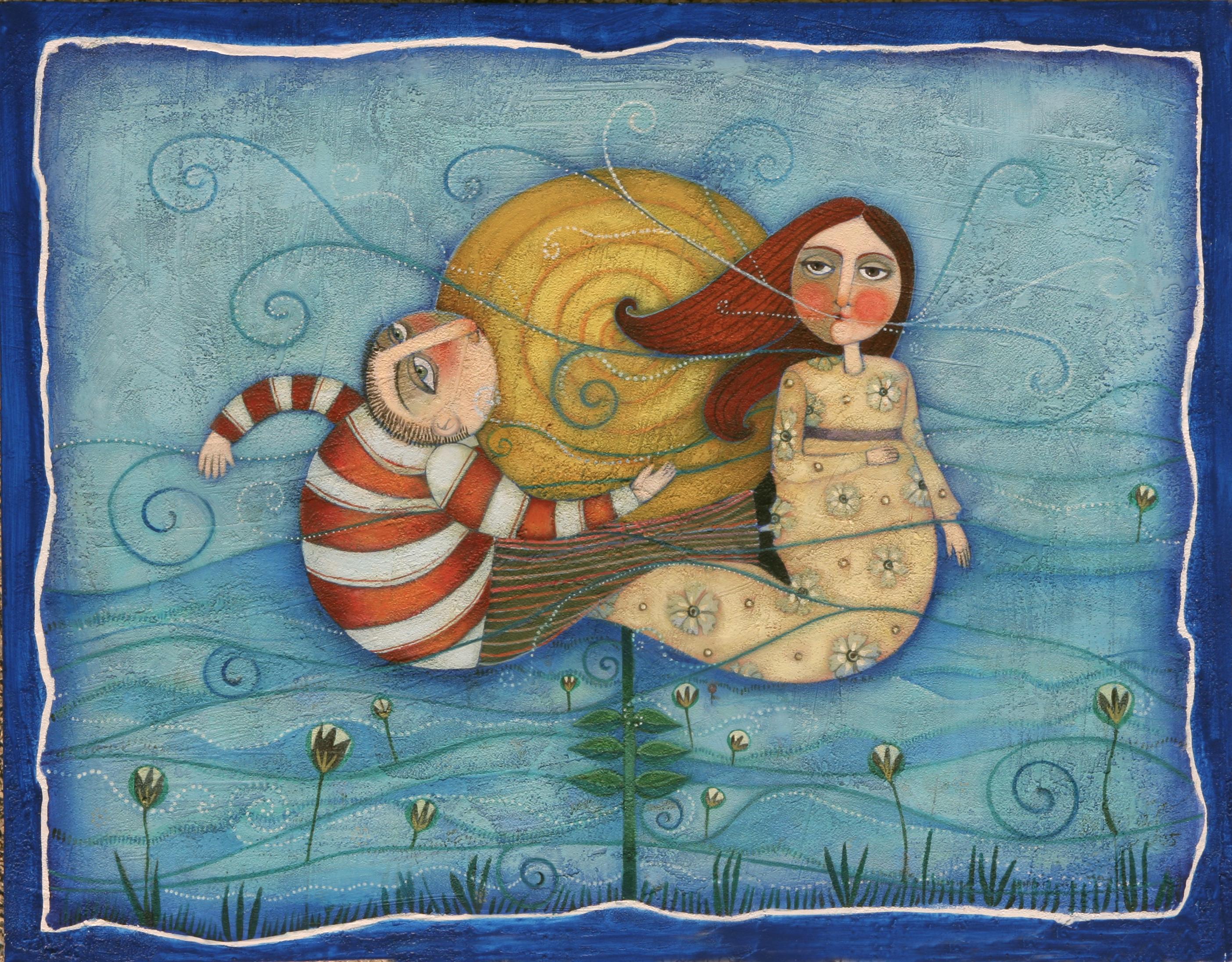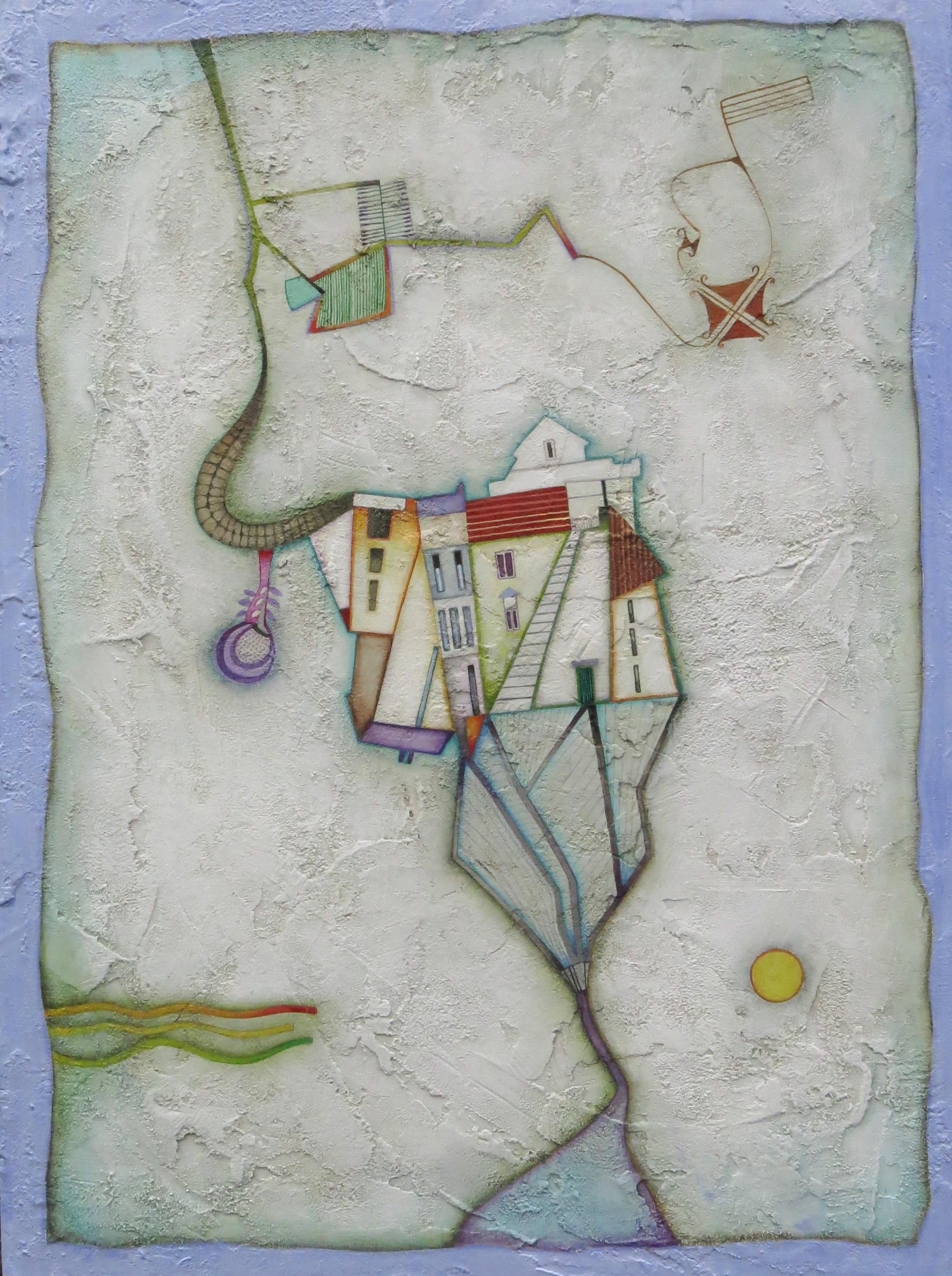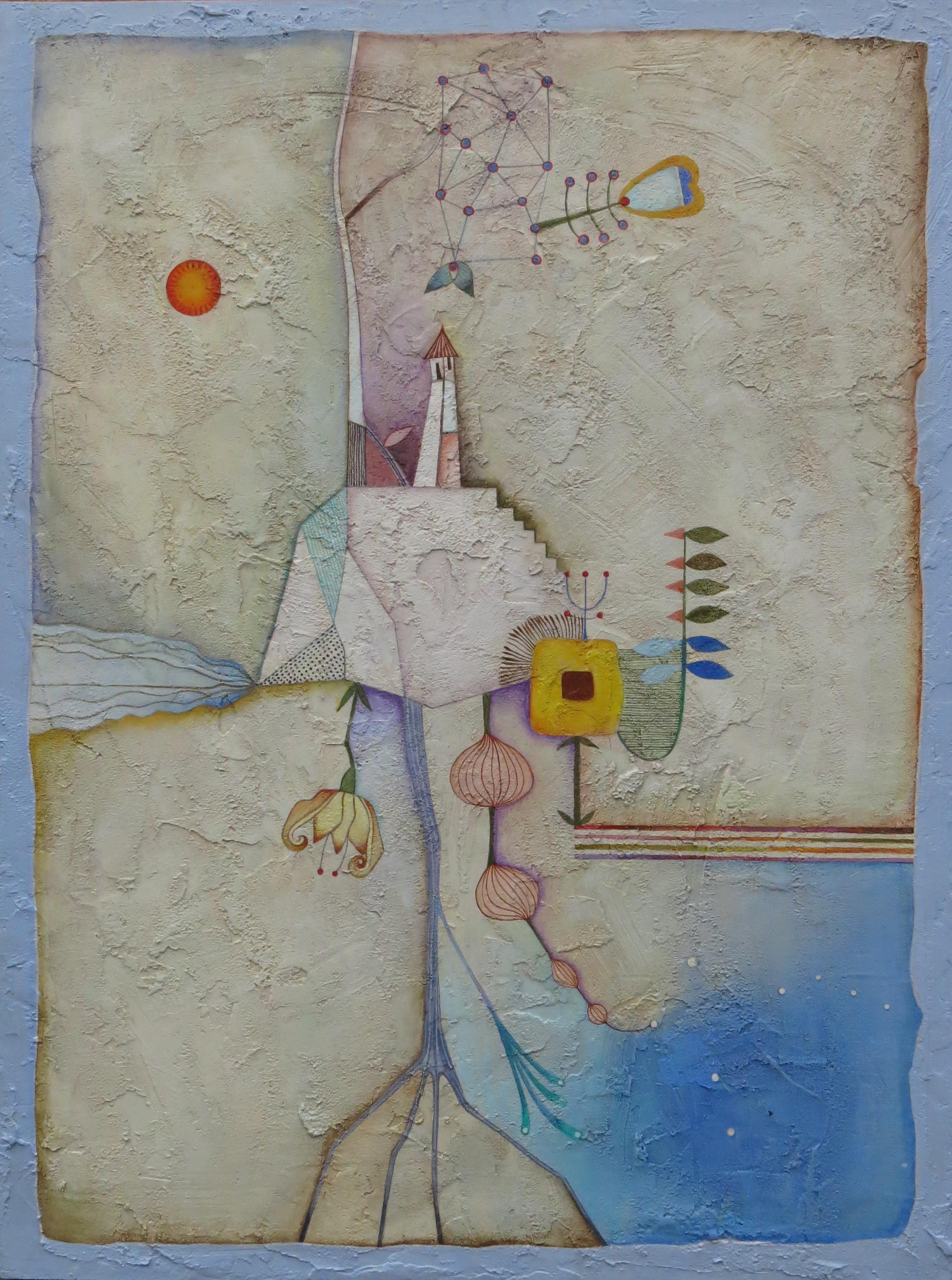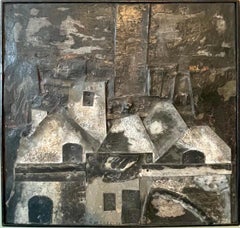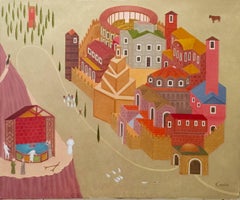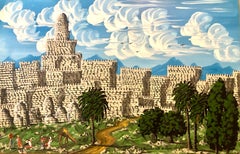
Vintage Israeli Kibbutz Folk Art Silk Batik Painting Jerusalem Maskit, Bezalel
View Similar Items
Want more images or videos?
Request additional images or videos from the seller
1 of 9
UnknownVintage Israeli Kibbutz Folk Art Silk Batik Painting Jerusalem Maskit, Bezalelc.1960
c.1960
About the Item
- Creation Year:c.1960
- Dimensions:Height: 40 in (101.6 cm)Width: 20 in (50.8 cm)
- Medium:
- Movement & Style:
- Period:
- Condition:some light fading, minor wear. frame needs to be replaced, please see photos.
- Gallery Location:Surfside, FL
- Reference Number:1stDibs: LU3823084423
About the Seller
4.9
Platinum Seller
These expertly vetted sellers are 1stDibs' most experienced sellers and are rated highest by our customers.
Established in 1995
1stDibs seller since 2014
1,539 sales on 1stDibs
Typical response time: 1 hour
More From This SellerView All
- French Outsider Art Brut Mixed Media Zinc Assemblage Sculpture Collage PaintingLocated in Surfside, FLMixed media assemblage sculpture/painting. Hand signed and dated recto and verso. Provenance: Galerie Alphonse Chave, bears their label verso Michel, Fernand (1913-1999) Born in 1913 in Neuviller-lès-Badonviller in the Vosges, Fernand Michel began working at the age of twelve in a Landes pottery factory. When his mother died, he went to live in Alsace with an aunt and became an art bookbinder. A lover of poetry, he bonded with Jean Vodaine, Jean Dubuffet and Alphonse Chave (Alphonse Chave was an art lover, dealer and collector. On November 15, 1947 in Vence, under the name Les Mages, he opened a contemporary art gallery which would also become a high place of art brut and unique art . The gallery took its final name - Galerie Alphonse Chave - in 1960. He exhibited Dado, Philippe Dereux, Jean Dubuffet, Max Ernst, Henri michaux, Louis Pons, Man Ray, Dorothea Tanning, Zao Wou-ki as well as other creators.) Around 1962, he began carving zinc after finding a plaque in a landfill. From this period, he made numerous assemblies, most often of large dimensions, which he called "zinc works" where buxom bathers, Venus callipyges, nuns and holy nitouches rub shoulders. The corroded and battered material over the years, used as is, gives his works a certain harshness, however softened by more ornamental pieces. Fernand Michel lived in Montpellier. He died in 1999. His work is present in the collection of La Fabuloserie in Dicy. Publications Revue "Création Franche" N ° 16, November 1998 Catalog "Donation Claude Massé", March 1999 Catalog "Collection Création Franche - 1989-2010", September 2010 Revue "Création Franche" N ° 38, June 2013 Franche Creation, Special Issue N ° 2, April 2015 His son Patrick Michel's collection is housed in Montpellier in the Musee d’arts brut, singulier and autres. "I used to accompany my father to his exhibitions since he was exhibited every year at the Galerie Chave in Vence. I still remember that Alphonse Chave once offered me a little toy (a car!) from his shop. I therefore met the artists Philippe Dereux, Armand Avril, François Ozenda, Pascal Verbena, Louis Pons, Jean Vodaine, Henri Comby, Fred Deux and Eugène Gabritschevsky- I took the decision to create the museum in order to save (and protect) my father’s work- my father was often classified under the ‘Art Brut’ label but in fact he belonged to the ‘Singular Art’ label... The term Art Brut exists since Jean Dubuffet gave it to us in 1945, covering self-taught and marginalised artists..The terms Outsider Art and Art Brut are fine with me- I place Nek Chand...Category
1960s Outsider Art Mixed Media
MaterialsMetal
- Fantastic Village Scene Modern Irish Magic Realism Oil PaintingBy Philip CastleLocated in Surfside, FLPhilip Castle was an Irish Painter and husband to artist Barry Castle He is rarely exhibited. His detailed, meticulous work took a long time to complete...Category
20th Century Folk Art Landscape Paintings
MaterialsCanvas, Oil
- Large Israeli Naive Art Screen Enamel Oil Painting Jerusalem Old City Folk ArtBy Gabriel CohenLocated in Surfside, FLJERUSALEM, Vielle du David, (City of David) Superlac (enamel) painting on paper, hand signed, titled and dated. Provenance: Michael Hittleman Gallery Los Angeles. Gabriel Cohen, (French-Israeli) Self taught, Naive painter was born in Paris in 1933, to parents from Jerusalem with a father who studied the kabbalah. Throughout World War II, the family hid from the Nazis in Paris. Images of Nazi soldiers appear in several of his paintings. In 1949, when Gabriel was 16, the family returned to Israel. They managed to save enough money to move back to the quarter where both parents were born: Ohel Moshe in Nachlaot. Gabriel served in the artillery corps and after the army, went back to live in his parents' house and earned a living polishing diamonds. The head of the polishing plant, who noticed his employee's artistic skill, allowed him to paint during work hours. He once asked Cohen if he could draw a tiger. Cohen drew him a tiger. And he did a lot of sculpting and painting on glass. He also loved to play the guitar, especially flamenco style. Critics say he is one of Israel's greatest naive-style painters. Along with Shalom of Safed, Kopel Gurwin and Natan Heber, He is renowned as one of Israel's greatest living naive-style folk art painters, recipient of the Jerusalem Prize for Art (1987), a permanent entry in encyclopedias of naive painting, who exhibited his work not only in Israel, but also in Paris, Venezuela, Denmark and Germany; the same Gabriel Cohen whose colorful , bold Naif paintings were exhibited at the Jewish Museum in New York in 1987 alongside works by Marc Chagall; the same Gabriel Cohen about whom curator and art scholar Gideon Ofrat says, "There is no questioning his greatness." He has shown in Paris on the Rue de Rosiers in the Marais. His impressions of his journeys, mostly imaginary, yet some real, are expressed in Cohen's paintings. Huge, colorful canvases rich in precise detail and fantasy, in which he paints the Eiffel Tower and the Russian steppes or the vistas of Paris and the Tower of Babel "In my opinion, it's also because the Tower of Babel has some kind of phallic, erotic meaning, but also because of the internationalism, of the mixture and confusion of nations, which is an essential element in Gabi Cohen's work," says Gideon Ofrat. There is no superlative that has not been lavished on Cohen's work by art critics, since he began showing his paintings at age 40, All the art critics seemed to agree at once that Cohen is one of the greatest naive-style painters in Israel. Their counterparts abroad seconded this view. About a year and a half ago, Zadka organized a show for Cohen at the Jerusalem Artists' House. The Tel Aviv Museum bought a painting of Gabi's and so did the Israel Museum, and several artists bought his drawings. He is a great, great painter. There is no painter who is more of a symbolist and illustrative artist than he is. As a painter myself, I admire him." The Yom Kippur War in 1973 sparked an artistic breakthrough for Cohen; it was at that time that he began to sit on the sidewalk after his work as a diamond polisher and paint. Not long afterward, in early 1974, he did a painting he called "Moses on the Mountain." Ruth Debel, of the Debel Gallery in Ein Kerem, passed by and saw it on the street. She asked how much he wanted for it, and for the first time in his life, he realized that his work had financial value. His first show was at the Debel Gallery in 1974. The response was overwhelming. Cohen was immediately declared a genius. His paintings at the gallery were purchased and he continued to create new paintings. That same year, he was invited to take part in a group exhibition of naive artists at the Kunsthaus in Zurich, and a year later, his work was included in a traveling show of naive-style artists from Israel that was exhibited in Denmark and Germany. Soon after that he was invited to be part of group shows in Venezuela and at the Tel Aviv Museum. Cohen had four solo shows at the Debel Gallery. Awards And Prizes 1987 Jerusalem Prize for Painting and Sculpture 1999 Shoshana Ish-Shalom Prize for special contribution to art, Jerusalem He has exhibited alongside all of the Israeli great artists. included in the Naive Art Group exhibition Gvanim Art Gallery, Jerusalem Rubin, Rachel Roman, Yitzhak Zarembo, Leah Moscovitz, Shalom (of Safed) Steinberg, Michael Denisov, Salva Harbon, Haim Cohen, Gabriel Chanannia, Joseph (Jojo) Local Hero...Category
20th Century Folk Art Landscape Paintings
MaterialsPaper, Oil, Alkyd
- Naive Abstract Landscape Folk ArtLocated in Surfside, FLFantasy landscape naive art oil painting, signed, S. Smith, left side of painting.Category
20th Century Folk Art Landscape Paintings
MaterialsOil, Board
- Mod 1970's Israeli Judaica Folk Art Jerusalem View Enamel on Copper PaintingLocated in Surfside, FLThis is a masterfully executed wall hanging enamel on copper painting of Jerusalem. it is signed in Hebrew. Israel has had a Vibrant Folk Art, Naive art scene for a long time now art...Category
20th Century Folk Art Landscape Paintings
MaterialsCopper, Enamel
- Magic Realist Surrealist Latin American Naive Fantasy PaintingBy German Ramon Duron LanzaLocated in Surfside, FLMagic realist fantasy painting in the manner of Ernst Fuchs and Arik Brauer. Naïve art is any form of visual art that is created by a person who lacks the formal education and training that a professional artist undergoes (in anatomy, art history, technique, perspective, ways of seeing). Unlike folk art, naïve art does not necessarily evince a distinct cultural context or tradition. Naïve art is recognized, and often imitated, for its childlike simplicity and frankness. Paintings of this kind typically have a flat rendering style with a rudimentary expression of perspective. One particularly influential painter of "naïve art" was Henri Rousseau (1844–1910), a French Post-Impressionist who was discovered by Pablo Picasso. Naïve art is often seen as outsider art that is by someone without formal (or little) training or degree. While this was true before the twentieth century, there are now academies for naïve art. Naïve art is now a fully recognized art genre, represented in art galleries worldwide. Museums devoted to naïve art now exist in Kecskemét, Hungary; Riga, Latvia; Jaen, Spain; Rio de Janeiro, Brasil; Vicq France and Paris. "Primitive art" is another term often applied to art by those without formal training, but is historically more often applied to work from certain cultures that have been judged socially or technologically "primitive" by Western academia, such as Native American, sub saharan African or Pacific Island art (see Tribal art). This is distinguished from the self-conscious, "primitive" inspired movement primitivism. Another term related to (but not completely synonymous with) naïve art is folk art. There also exist the terms "naïvism" and "primitivism" which are usually applied to professional painters working in the style of naïve art (like Paul Gauguin, Mikhail Larionov, Paul Klee). At all events, naive art can be regarded as having occupied an "official" position in the annals of twentieth-century art since - at the very latest - the publication of the Der Blaue Reiter, an almanac in 1912. Wassily Kandinsky and Franz Marc, who brought out the almanac, presented 6 reproductions of paintings by le Douanier' Rousseau (Henri Rousseau), comparing them with other pictorial examples. However, most experts agree that the year that naive art was "discovered" was 1885, when the painter Paul Signac became aware of the talents of Henri Rousseau and set about organizing exhibitions of his work in a number of prestigious galleries. The Earth Group (Grupa Zemlja) were Croatian artists, architects and intellectuals active in Zagreb from 1929 to 1935. The group included the painters Krsto Hegedušić, Edo Kovačević, Omer Mujadžić, Kamilo Ružička, Ivan Tabaković, and Oton Postružnik, the sculptors Antun Augustinčić, Frano Kršinić, and the architect Drago Ibler. A term applied to Yugoslav (Croatian) naive painters working in or around the village of Hlebine, near the Hungarian border, from about 1930. Some of the best known naive artists are Dragan Gaži, Ivan Generalić, Josip Generalić, Krsto Hegedušić, Mijo Kovačić, Ivan Lacković-Croata, Franjo Mraz, Ivan Večenaj and Mirko Virius. Camille Bombois (1883–1970) Ferdinand Cheval, known as 'le facteur Cheval' (1836–1924) Henry Darger (1892–1973) L. S. Lowry (1887–1976) Grandma Moses, Anna Mary Robertson (1860–1961) Nikifor (1895–1968) Poland, Horace Pippin (1888–1946) Jon Serl (1894-1993) United States Alfred Wallis (1855–1942) Scottie Wilson (1890–1972) Gesner Abelard (b. 1922) Jan Balet (1913–2009) Michel Delacroix (b. 1933) France Howard Finster (1916–2001) Ivan Rabuzin (1921–2008) Spontaneous Art Museum in Brussels Art en Marge Museum in Brussels MADmusée in Liege International Museum of Naive Art of Brazil in Cosme Velho, Rio de Janeiro Gallery Jacques Ardies in São Paulo Musée international d'art naïf de Magog in Magog Croatian Museum of Naïve Art in Zagreb Gallery of Croatian Naïve Art...Category
20th Century Folk Art Figurative Paintings
MaterialsCanvas, Acrylic
You May Also Like
- "The First Time on Telephone" Black African American Folk PaintingBy Johnny BanksLocated in San Antonio, TXJohnny Banks (1912-1988) San Antonio Artist Image Size: 11.25 x 20 Frame Size: 17 x 28 Medium: Pen, Pencil, Crayon, Marker "The First Time on Telephone" Biography Johnny Banks (1912-1988) In my opinion one of the greatest Texas folk artists of all time. The following information was compiled and submitted by Stephanie Reeves: John Willard Banks, San Antonio, Texas, African American Folk...Category
1970s Folk Art Landscape Paintings
MaterialsCrayon, Mixed Media
- "Two Riding Through The Woods" Black Texas Folk Artist Johnny Banks AfricanBy Johnny BanksLocated in San Antonio, TXJohnny Banks (1912-1988) San Antonio Artist Image Size: 10.5 x 13.5 Frame Size: 16.5 x 19 Medium: Pen, Pencil, Crayon, Marker "Two Riding Through The Woods" Biography Johnny Banks (1912-1988) In my opinion one of the greatest Texas folk artists of all time. The following information was compiled and submitted by Stephanie Reeves: John Willard Banks, San Antonio, Texas, African American Folk Artist John Willard Banks, black self-taught artist, the son of Charlie and Cora Lee (McIntyre) Banks, was born on November 7, 1912, near Seguin, Texas. At the age of five his parents took him to San Antonio, where he attended Holy Redeemer School until the age of nine, when his parents were divorced and John returned to his grandparents' farm near Seguin. From childhood Banks's favorite pastime was drawing pictures on his Big Chief tablet. He later recalled, "As a kid I used to lie flat on my stomach, drawing and drawing. . . . My mother had to kick me off the floor to sweep." While helping out on his grandparents' farm, Banks completed the tenth grade before striking out on his own. His favorite activities during his youth were singing in a gospel quartet and playing baseball. In his adult years he worked in oilfields and cotton fields, drove a truck, and tended a San Antonio service station. During World War II he joined the army; he held the rank of sergeant and was stationed in the Philippines. After the war he returned to San Antonio, where he worked as a custodian at Kelly Air Force Base, at Fort Sam Houston, and at a local television station. Banks married Edna Mae Mitchell in 1928, and they had five children. The marriage ended in divorce around 1960. In 1963 he married Earlie Smith. His art career began in 1978 while he was recuperating from an illness for which he had been hospitalized. Banks's wife admired her husband's drawings and secretly took several of them to a San Antonio laundromat. There she hung the drawings on the wall, offering them for sale at the price of fourteen dollars. They were purchased and taken to a gallery for framing. Quite by chance, a San Antonio physician and collector of works of art by black artists...Category
1970s Folk Art Landscape Paintings
MaterialsCrayon, Mixed Media
- "The Safari Hunt for the Man Eating Tiger" San Antonio Texas Black Folk ArtistBy Johnny BanksLocated in San Antonio, TXJohnny Banks (1912-1988) San Antonio Artist Image Size: 14 x 22 Frame Size: 21 x 29 Medium: mixed media "The Safari Hunt for the Man Eating Tiger" Biography Johnny Banks (1912-1988) In my opinion one of the greatest Texas folk artists of all time. The following information was compiled and submitted by Stephanie Reeves: John Willard Banks, San Antonio, Texas, African American Folk Artist John Willard Banks, black self-taught artist, the son of Charlie and Cora Lee (McIntyre) Banks, was born on November 7, 1912, near Seguin, Texas. At the age of five his parents took him to San Antonio, where he attended Holy Redeemer School until the age of nine, when his parents were divorced and John returned to his grandparents' farm near Seguin. From childhood Banks's favorite pastime was drawing pictures on his Big Chief tablet. He later recalled, "As a kid I used to lie flat on my stomach, drawing and drawing. . . . My mother had to kick me off the floor to sweep." While helping out on his grandparents' farm, Banks completed the tenth grade before striking out on his own. His favorite activities during his youth were singing in a gospel quartet and playing baseball. In his adult years he worked in oilfields and cotton fields, drove a truck, and tended a San Antonio service station. During World War II he joined the army; he held the rank of sergeant and was stationed in the Philippines. After the war he returned to San Antonio, where he worked as a custodian at Kelly Air Force Base, at Fort Sam Houston, and at a local television station. Banks married Edna Mae Mitchell in 1928, and they had five children. The marriage ended in divorce around 1960. In 1963 he married Earlie Smith. His art career began in 1978 while he was recuperating from an illness for which he had been hospitalized. Banks's wife admired her husband's drawings and secretly took several of them to a San Antonio laundromat. There she hung the drawings on the wall, offering them for sale at the price of fourteen dollars. They were purchased and taken to a gallery for framing. Quite by chance, a San Antonio physician and collector of works of art by black artists...Category
1970s Folk Art Landscape Paintings
MaterialsCrayon, Mixed Media
- "The Living Dead" San Antonio Texas Black Folk Artist Johnny BanksBy Johnny BanksLocated in San Antonio, TXJohnny Banks (1912-1988) San Antonio Artist Image Size: 14 x 22 Frame Size: 21 x 29 Medium: mixed media "The Living Dead" Biography Johnny Banks (1912-1988) In my opinion one of the greatest Texas folk artists of all time. The following information was compiled and submitted by Stephanie Reeves: John Willard Banks, San Antonio, Texas, African American Folk Artist John Willard Banks, black self-taught artist, the son of Charlie and Cora Lee (McIntyre) Banks, was born on November 7, 1912, near Seguin, Texas. At the age of five his parents took him to San Antonio, where he attended Holy Redeemer School until the age of nine, when his parents were divorced and John returned to his grandparents' farm near Seguin. From childhood Banks's favorite pastime was drawing pictures on his Big Chief tablet. He later recalled, "As a kid I used to lie flat on my stomach, drawing and drawing. . . . My mother had to kick me off the floor to sweep." While helping out on his grandparents' farm, Banks completed the tenth grade before striking out on his own. His favorite activities during his youth were singing in a gospel quartet and playing baseball. In his adult years he worked in oilfields and cotton fields, drove a truck, and tended a San Antonio service station. During World War II he joined the army; he held the rank of sergeant and was stationed in the Philippines. After the war he returned to San Antonio, where he worked as a custodian at Kelly Air Force Base, at Fort Sam Houston, and at a local television station. Banks married Edna Mae Mitchell in 1928, and they had five children. The marriage ended in divorce around 1960. In 1963 he married Earlie Smith. His art career began in 1978 while he was recuperating from an illness for which he had been hospitalized. Banks's wife admired her husband's drawings and secretly took several of them to a San Antonio laundromat. There she hung the drawings on the wall, offering them for sale at the price of fourteen dollars. They were purchased and taken to a gallery for framing. Quite by chance, a San Antonio physician and collector of works of art by black artists...Category
1970s Folk Art Landscape Paintings
MaterialsCrayon, Mixed Media
- "Daddy Playing in the Mud" San Antonio Texas Black Folk Artist Johnny BanksBy Johnny BanksLocated in San Antonio, TXJohnny Banks (1912-1988) San Antonio Artist Image Size: 13.75 x 20 Frame Size: 20 x 27 Medium: Pen, Pencil, Crayon, Marker "Daddy Playing in the Mud" Biography Johnny Banks (1912-1988) In my opinion one of the greatest Texas folk artists of all time. The following information was compiled and submitted by Stephanie Reeves: John Willard Banks, San Antonio, Texas, African American Folk Artist John Willard Banks, black self-taught artist, the son of Charlie and Cora Lee (McIntyre) Banks, was born on November 7, 1912, near Seguin, Texas. At the age of five his parents took him to San Antonio, where he attended Holy Redeemer School until the age of nine, when his parents were divorced and John returned to his grandparents' farm near Seguin. From childhood Banks's favorite pastime was drawing pictures on his Big Chief tablet. He later recalled, "As a kid I used to lie flat on my stomach, drawing and drawing. . . . My mother had to kick me off the floor to sweep." While helping out on his grandparents' farm, Banks completed the tenth grade before striking out on his own. His favorite activities during his youth were singing in a gospel quartet and playing baseball. In his adult years he worked in oilfields and cotton fields, drove a truck, and tended a San Antonio service station. During World War II he joined the army; he held the rank of sergeant and was stationed in the Philippines. After the war he returned to San Antonio, where he worked as a custodian at Kelly Air Force Base, at Fort Sam Houston, and at a local television station. Banks married Edna Mae Mitchell in 1928, and they had five children. The marriage ended in divorce around 1960. In 1963 he married Earlie Smith. His art career began in 1978 while he was recuperating from an illness for which he had been hospitalized. Banks's wife admired her husband's drawings and secretly took several of them to a San Antonio laundromat. There she hung the drawings on the wall, offering them for sale at the price of fourteen dollars. They were purchased and taken to a gallery for framing. Quite by chance, a San Antonio physician and collector of works of art by black artists...Category
1970s Folk Art Landscape Paintings
MaterialsCrayon, Mixed Media
- "African Village" San Antonio Texas Black Folk Artist Johnny BanksBy Johnny BanksLocated in San Antonio, TXJohnny Banks (1912-1988) San Antonio Artist Image Size: 14 x 22 Frame Size: 21 x 29 Medium: mixed media Dated 1981 "African Village" Biography Johnny Banks (1912-1988) In my opinion one of the greatest Texas folk artists of all time. The following information was compiled and submitted by Stephanie Reeves: John Willard Banks, San Antonio, Texas, African American Folk Artist John Willard Banks, black self-taught artist, the son of Charlie and Cora Lee (McIntyre) Banks, was born on November 7, 1912, near Seguin, Texas. At the age of five his parents took him to San Antonio, where he attended Holy Redeemer School until the age of nine, when his parents were divorced and John returned to his grandparents' farm near Seguin. From childhood Banks's favorite pastime was drawing pictures on his Big Chief tablet. He later recalled, "As a kid I used to lie flat on my stomach, drawing and drawing. . . . My mother had to kick me off the floor to sweep." While helping out on his grandparents' farm, Banks completed the tenth grade before striking out on his own. His favorite activities during his youth were singing in a gospel quartet and playing baseball. In his adult years he worked in oilfields and cotton fields, drove a truck, and tended a San Antonio service station. During World War II he joined the army; he held the rank of sergeant and was stationed in the Philippines. After the war he returned to San Antonio, where he worked as a custodian at Kelly Air Force Base, at Fort Sam Houston, and at a local television station. Banks married Edna Mae Mitchell in 1928, and they had five children. The marriage ended in divorce around 1960. In 1963 he married Earlie Smith. His art career began in 1978 while he was recuperating from an illness for which he had been hospitalized. Banks's wife admired her husband's drawings and secretly took several of them to a San Antonio laundromat. There she hung the drawings on the wall, offering them for sale at the price of fourteen dollars. They were purchased and taken to a gallery for framing. Quite by chance, a San Antonio physician and collector of works of art by black artists...Category
1970s Folk Art Landscape Paintings
MaterialsCrayon, Mixed Media

